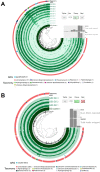Gentamicin at sub-inhibitory concentrations selects for antibiotic resistance in the environment
- PMID: 37938295
- PMCID: PMC9723587
- DOI: 10.1038/s43705-022-00101-y
Gentamicin at sub-inhibitory concentrations selects for antibiotic resistance in the environment
Abstract
Antibiotics released into the environment at low (sub-inhibitory) concentrations could select for antibiotic resistance that might disseminate to the human microbiome. In this case, low-level anthropogenic sources of antibiotics would have a significant impact on human health risk. In order to provide data necessary for the evaluation of this risk, we implemented river water microcosms at both sub-inhibitory and inhibitory concentrations of gentamicin as determined previously based on bacterial growth in enriched media. Using metagenomic sequencing and qPCR/RT-qPCR, we assessed the effects of gentamicin on water bacterial communities and their resistome. A change in the composition of total and active communities, as well as a gentamicin resistance gene selection identified via mobile genetic elements, was observed during a two-day exposure. We demonstrated the effects of sub-inhibitory concentrations of gentamicin on bacterial communities and their associated resistome in microcosms (simulating in situ conditions). In addition, we established relationships between antibiotic dose and the magnitude of the community response in the environment. The scope of resistance selection under sub-inhibitory concentrations of antibiotics and the mechanisms underlying this process might provide the basis for understanding resistance dispersion and associated risks in relatively low impacted ecosystems.
© 2022. The Author(s).
Conflict of interest statement
The authors declare no competing interests.
Figures



References
-
- Kemper N. Veterinary antibiotics in the aquatic and terrestrial environment. Ecol Indic. 2008;8:1–13. doi: 10.1016/j.ecolind.2007.06.002. - DOI
-
- Bengtsson-Palme J, Kristiansson E, Larsson DGJ Environmental factors influencing the development and spread of antibiotic resistance. FEMS Microbiol Rev. 2017;(October 2017):68–80. Available from: http://academic.oup.com/femsre/advance-article/doi/10.1093/femsre/fux053... - DOI - PMC - PubMed

